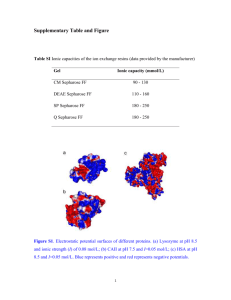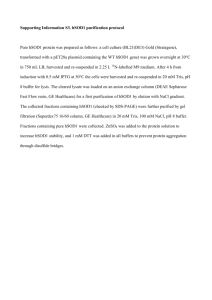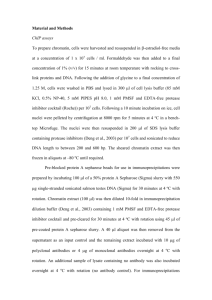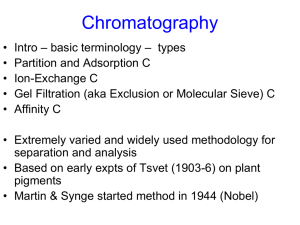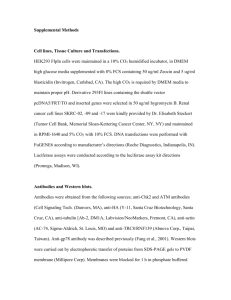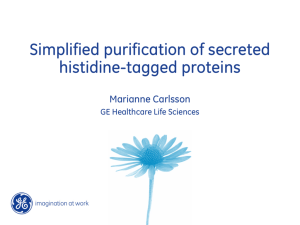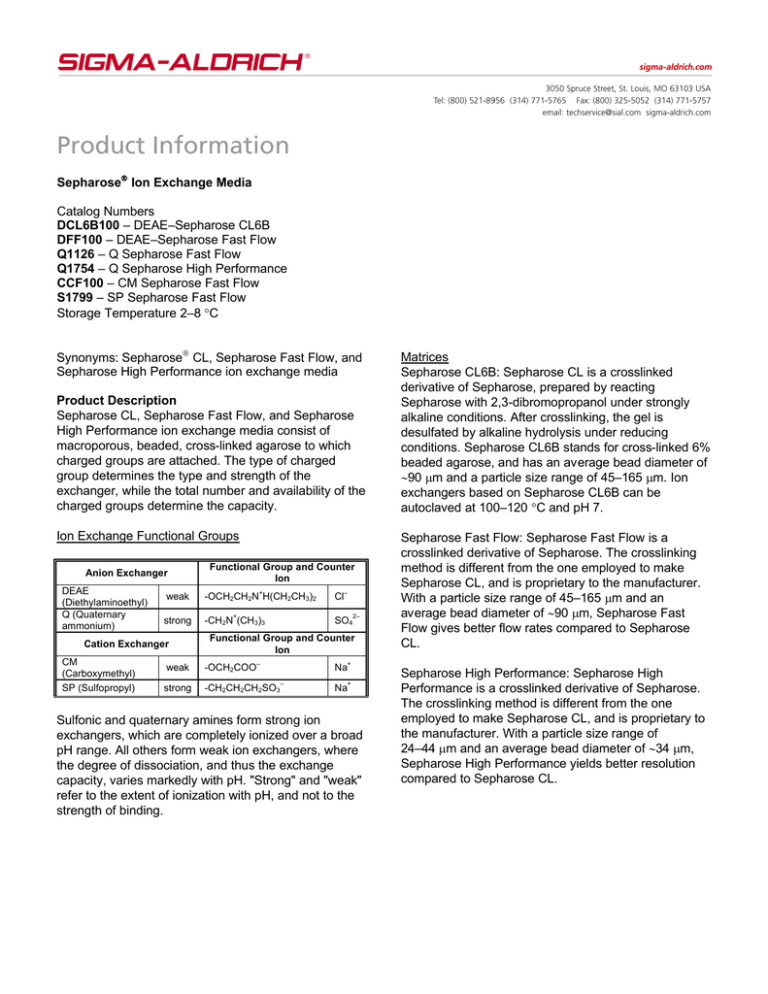
Sepharose Ion Exchange Media
Catalog Numbers
DCL6B100 – DEAE–Sepharose CL6B
DFF100 – DEAE–Sepharose Fast Flow
Q1126 – Q Sepharose Fast Flow
Q1754 – Q Sepharose High Performance
CCF100 – CM Sepharose Fast Flow
S1799 – SP Sepharose Fast Flow
Storage Temperature 2–8 °C
Synonyms: Sepharose CL, Sepharose Fast Flow, and
Sepharose High Performance ion exchange media
Product Description
Sepharose CL, Sepharose Fast Flow, and Sepharose
High Performance ion exchange media consist of
macroporous, beaded, cross-linked agarose to which
charged groups are attached. The type of charged
group determines the type and strength of the
exchanger, while the total number and availability of the
charged groups determine the capacity.
Ion Exchange Functional Groups
Anion Exchanger
DEAE
(Diethylaminoethyl)
Q (Quaternary
ammonium)
+
weak
-OCH2CH2N H(CH2CH3)2
strong
-CH2N (CH3)3
Cation Exchanger
CM
(Carboxymethyl)
SP (Sulfopropyl)
Functional Group and Counter
Ion
+
–
Cl
SO4
2–
Functional Group and Counter
Ion
–
weak
-OCH2COO
strong
-CH2CH2CH2SO3
+
Na
–
+
Na
Sulfonic and quaternary amines form strong ion
exchangers, which are completely ionized over a broad
pH range. All others form weak ion exchangers, where
the degree of dissociation, and thus the exchange
capacity, varies markedly with pH. "Strong" and "weak"
refer to the extent of ionization with pH, and not to the
strength of binding.
Matrices
Sepharose CL6B: Sepharose CL is a crosslinked
derivative of Sepharose, prepared by reacting
Sepharose with 2,3-dibromopropanol under strongly
alkaline conditions. After crosslinking, the gel is
desulfated by alkaline hydrolysis under reducing
conditions. Sepharose CL6B stands for cross-linked 6%
beaded agarose, and has an average bead diameter of
∼90 µm and a particle size range of 45–165 µm. Ion
exchangers based on Sepharose CL6B can be
autoclaved at 100–120 °C and pH 7.
Sepharose Fast Flow: Sepharose Fast Flow is a
crosslinked derivative of Sepharose. The crosslinking
method is different from the one employed to make
Sepharose CL, and is proprietary to the manufacturer.
With a particle size range of 45–165 µm and an
average bead diameter of ∼90 µm, Sepharose Fast
Flow gives better flow rates compared to Sepharose
CL.
Sepharose High Performance: Sepharose High
Performance is a crosslinked derivative of Sepharose.
The crosslinking method is different from the one
employed to make Sepharose CL, and is proprietary to
the manufacturer. With a particle size range of
24–44 µm and an average bead diameter of ∼34 µm,
Sepharose High Performance yields better resolution
compared to Sepharose CL.
2
Sepharose Anion Exchangers
Catalog
Number
DCL6B100
DFF100
Q1126
Q1754
Type and Properties
DEAE–Sepharose
Suspension in 20% ethanol with 0.5 M NaCl
Matrix: Sepharose CL6B
6
Approx. Exclusion Limit: Average MW 4 × 10
Exchange Capacity: 130–170 µeq/mL gel
Binding Capacity: 170 mg HSA per mL gel
pH Stability: 3–12
DEAE–Sepharose
Suspension in 20% ethanol
Matrix: Sepharose Fast Flow
6
Approx. Exclusion Limit: Average MW 4 × 10
Exchange Capacity: 110–160 µeq/mL gel
Binding Capacity: 110 mg HSA per mL gel
pH Stability: 2–13
Q SEPHAROSE
Suspension in 20% ethanol
Matrix: Sepharose Fast Flow
6
Approx. Exclusion Limit: Average MW 4 × 10
Exchange Capacity: 180–250 µeq/mL gel
Binding Capacity: 120 mg HSA per mL gel
pH Stability: 2–12
Q SEPHAROSE
Suspension in 20% ethanol
Matrix: Sepharose High Performance
6
Approx. Exclusion Limit: Average MW 4 × 10
Exchange Capacity: 150–200 µeq/mL gel
Binding Capacity: 120 mg HAS per mL gel
pH Stability: 2–12
Sepharose Cation Exchangers
Catalog
Number
CCF100
S1799
Storage/Stability
Store Sepharose ion exchanger media at 2–8 °C in
water or a dilute buffer of choice with 20% ethanol
added as an antibacterial agent.
Procedure
Cationic versus Anionic Exchanger
If the sample components are most stable below their
pI values, a cation exchanger should be used. If they
are most stable above their pI values, an anion
exchanger should be used. If stability is good over a
wide pH range on both sides of the pI, either or both
types of ion exchanger may be used.
Strong versus Weak Ion Exchanger
Most proteins have pI values within the range 5.5–7.5,
and can thus be separated on both strong and weak ion
exchangers. In cases where maximum resolution
occurs at an extreme pH and the molecules of interest
are stable at that pH, a strong ion exchanger should be
used.
Choice of Buffer, pH, and Ionic Strength
The highest ionic strength, which permits binding
should normally be used. The required buffer
concentration varies from substance to substance, but
usually an ionic strength of at least 10 mM is required to
ensure adequate buffering capacity. Since salts
(including buffers) help stabilize proteins in solution,
their concentration should be high enough to prevent
denaturation and precipitation.
Type and Properties
CM SEPHAROSE
Suspension in 20% ethanol
Matrix: Sepharose Fast Flow
6
Approx. Exclusion Limit: Average MW 4 × 10
Exchange Capacity: 90–130 µeq/mL gel
Binding Capacity: 50 mg RNase per mL gel
pH Stability: 4–13
SP SEPHAROSE
Suspension in 20% ethanol
Matrix: Sepharose Fast Flow
6
Approx. Exclusion Limit: Average MW 4 × 10
Exchange Capacity: 180–250 µeq/mL
Binding Capacity: 120 mg BSA per mL gel
pH Stability: 4–13
Precautions and Disclaimer
This product is for R&D use only, not for drug,
household, or other uses. Please consult the Material
Safety Data Sheet for information regarding hazards
and safe handling practices.
Ion Exchanger
Recommended
Buffer Ions
Anion Exchanger
Cationic
DEAE Sepharose
CL6B
DEAE Sepharose
Fast Flow
Q Sepharose
Fast Flow
Q Sepharose
High Performance
Cation
Exchanger
CM Sepharose
Fast Flow
SP Sepharose
Fast Flow
(e.g., alkylamines,
alcohol, ammonium,
ethylenediamine,
imidazole, Tris,
pyridine, etc...)
Anionic
(e.g., acetate,
barbiturate, citrate,
glycine, phosphate,
etc...)
pH
Operate within
0.5 pH unit of the
buffer's pKa and, to
facilitate binding, at
least 1 pH unit
above the pI of the
protein.
Operate within
0.5 pH unit of the
buffer's pKa and, to
facilitate binding, at
least 1 pH unit
below the pI of the
protein.
3
1. Allow the ion exchange medium and ∼10 column
volumes (CV) of buffer to equilibrate to the
temperature selected for the chromatographic run.
2. Mix the pre-swollen suspension with starting buffer
to form a moderately thick slurry, which consists of
∼75% settled gel and 25% liquid.
3. Degas the gel under vacuum at the temperature of
column operation.
4. Mount the column vertically on a suitable stand, out
of the way of direct sunlight or drafts, which may
cause temperature fluctuations.
5. Pour a small amount of buffer into the empty
column and allow it to flow through spaces to
eliminate air pockets.
6. Pour the suspension of ion exchange medium
prepared in step 3 into the column by allowing it to
flow gently down the side of the tube in order to
avoid bubble formation.
7. For consistent flow rates and reproducible
separations, connect a pump to the column.
8. Fill the remainder of the column to the top with
buffer. Allow ∼5 CV of buffer to drain through the
bed at a flow rate at least 133% of the flow rate to
be used in the procedure. The bed height should
have settled to a constant height.
9. Using a syringe or similar instrument, apply the
sample dissolved in starting buffer to the column.
For isocratic separations, the sample volume
should range between 1–5% of the column volume.
If the chromatographic run involves elution with a
gradient, the sample mass applied is of much
greater importance than the sample volume, and
the sample should be applied in a low ionic strength
medium. Ion exchange is used to concentrate the
sample as well as fractionate it.
10. Elution:
If only unwanted substances in the sample are
adsorbed, or if sample components are
differentially retarded under isocratic conditions, the
starting buffer can also be used as the eluent.
Normally, however, separation and elution are
achieved by selectively decreasing the affinity of
the molecules for the charged groups on the resin
by changing the pH and/or ionic strength of the
eluent, this procedure is termed gradient elution.
11. Regeneration:
Washing the column with a high ionic strength salt
solution (e.g., 1 M NaCl), or changing the pH to the
low and high extremes tolerable, is usually
sufficient to remove all reversibly bound material.
When necessary, lipids and precipitated proteins
can be removed by washing with 1 CV of 1–2 M
NaCl, followed by 1 CV of 0.1 M NaOH in 0.5 M
NaCl. Rinse with several CV of water, then reequilibrate the resin with starting buffer. If base was
used, adjust the pH of the resin to neutral before
storing or using.
References
The information was abstracted, for customer
convenience, from a supplier technical manual and
several supplier information sheets. Complete copies of
supplier data are available upon request from Sigma
Research Technical Service.
Sepharose is a registered trademark of GE Healthcare
Bio-Sciences AB.
JJJ,GCY,MAM 08/12-1
2012 Sigma-Aldrich Co. LLC. All rights reserved. SIGMA-ALDRICH is a trademark of Sigma-Aldrich Co. LLC, registered in the US and other
countries. Sigma brand products are sold through Sigma-Aldrich, Inc. Purchaser must determine the suitability of the product(s) for their
particular use. Additional terms and conditions may apply. Please see product information on the Sigma-Aldrich website at
www.sigmaaldrich.com and/or on the reverse side of the invoice or packing slip.

